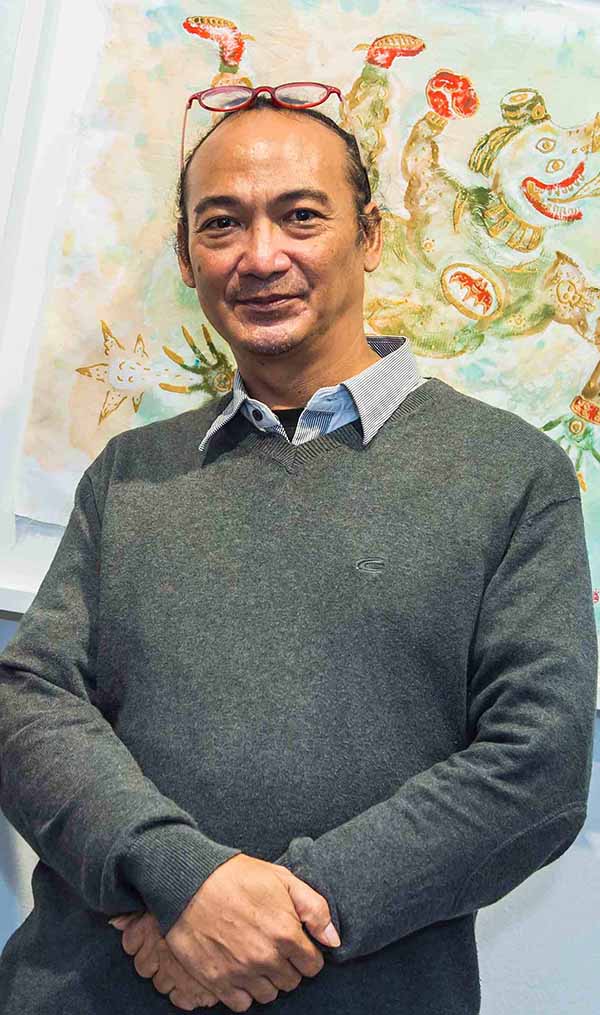Heri Dono
1960, Jakarta,Indonesia
Heri Dono is unquestionably one among the Indonesian contemporary artists from the late 1980s generation that are best known to contemporary art international community. Since early in his career up to now, he has been around the world to respond to exhibition and workshop invitations in various countries. Heri Dono is known through his installation that results from his experiments with the most popular Javanese folk theater: Wayang.
In the Wayang performance, a number of artistic and extra-artistic elements – visual arts, singing, music, storytelling, mythology promotion of a philosophy of life, social criticisms, and humor – merge into a coherent unity to make a generic performance comprising complex elements of multimedia. Moreover, all this is coupled with the setting of a Wayang performance event that provides space for social interaction among the audience.
Heri Dono installations give the best example of the attempts at creatively revitalizing traditional art practice profoundly rooted in Indonesia. In a lot of his installations and performances, Heri Dono effectively makes use of performativity and interactivity potencies so that the works are involved in intense dialogs with their audiences.
In his paintings, Heri Dono makes the most use of wild deformations and free fantasies out of which emerge characters of Wayang stories. Adding his profound knowledge of children’s cartoon films, animation films, and comics, Heri Dono’s canvas is always filled with highly astonishing characters of intertwined fantastic and absurd stories. In all these,Heri Dono will sometimes insert his own critical remarks on socio-political issues in Indonesia and abroad.
Heri Dono participated in no less than 31 international biennales. He is the only contemporary Indonesian artist to have been invited to the Biennale Arte’s own curatorial exhibition in 2003 (Zone of Urgency), he awarded the Prince Claus Award for Culture and Development (1998), the Unesco Prize in 2000, and the Anugerah Adhikarya Rupa (Arts Award) from the Indonesian Government in 2014.
He participated in 270 exhibitions including 31 international biennales such asSão Paolo Biennial (2004 and 1996), Sydney Biennale (1996), Shanghai Biennale (2000), Yokohama Biennale (2001), Asia Pacific Triennial (2002 and 1993), Taipei Biennial (2004), Gwangju Biennale (2006 and 1995), Sharjah Biennial (2005) and so on.
เฮริ โดโน
เกิด พ.ศ. 2503, จาการ์ต้า พำนักและทำงานที่ ยอกจาการ์ต้า สาธารณรัฐอินโดนีเซีย
เฮริ โดโน เป็นศิลปินร่วมสมัยของอินโดนีเซียจากยุคคริสต์ทศวรรษ 1980’s ที่เป็นที่รู้จักมากที่สุดในเวทีศิลปะนานาชาติ เขาเดินทางไปแสดงงานมาแล้วทั่วโลก เฮริมีชื่อเสียง โด่งดังจากการทำงานทดลองที่ผสานวัฒนธรรมนิยมพื้นเมือง และวิถีชีวิตของชุมชนของชาวชวา อย่างหนังตะลุง วาหยัง (Wayang) เข้ามาอยู่ร่วมในงานศิลปะจัดวางของเขา
การแสดงวาหยัง เป็นการรวมเอาศาสตร์และศิลป์หลายแขนงเข้าด้วยกัน ทั้งทัศนศิลป์, การแสดง, ดนตรี, การละเล่นพื้นเมือง, การเล่านิทานพื้นบ้านและตำนานต่างๆ ที่ส่งเสริมความเชื่อและปรัชญาชีวิต ไปจนถึงการแสดงที่วิพากษ์ หยอกล้อเสียดสีสังคม เป็นสื่อการแสดงออกที่มีความหลากหลายซับซ้อน และเปิดโอกาสให้ผู้ชมได้มีส่วนร่วมในการแสดงออกทางความคิดเห็นอีกด้วย โดโน ใช้การแสดงออก เพื่อเล่าเรื่องราวจากรากฐานทางวัฒนธรรมอันยาวนานของอินโดนีเซีย ที่ดูเหมือนว่าไม่มีทีท่าจะปรับเปลี่ยนได้ แต่การกระตุ้นให้เกิดการวิพากษ์ ให้ประชาชน ในชุมชนได้ร่วมกันคิด วิเคราะห์ หรือ แม้กระทั่งตั้งคำถาม เป็นสิ่งที่ศิลปินหนุ่มตั้งใจทำมาตลอด
ด้านงานจิตรกรรม เฮริ โดโน มักจะใช้จินตนาการ และการแปลงรูปลักษณ์ตัวละครวาหยัง ให้ผิดเพี้ยนไปจากของเดิม ผนวกกับความรู้ในเรื่องภาพยนตร์และแอนนิเมชั่นของเด็ก ผืนผ้าใบของเขาจึงเต็มไปด้วยตัวละครที่มีรูปร่างหน้าตาแปลกประหลาดและชวนพิศวง และแน่นอนว่าศิลปินได้สอดแทรกสารถึงผู้ชมในการวิพากษ์วิจารณ์ประเด็นทางสังคมและการเมือง ทั้งในประเทศอินโดนีเซียเอง และในระดับนานาชาติอีกด้วย
เฮริ โดโน เข้าร่วมแสดงผลงานใน เทศกาลศิลปะร่วมสมัยนานาชาติ เบียนนาเล่ ไม่ต่ำกว่า 31 ครั้ง และเป็นศิลปินร่วมสมัยชาวอินโดนีเซียเพียงหนึ่งเดียวที่ได้รับเชิญเข้าร่วมใน the Biennale Arte (Zone of Urgency) ในปี พ.ศ. 2546, เขาได้รับรางวัล Prince Claus Award for Culture and Development ในปี พ.ศ. 2541, the Unesco Prize ในปีพ.ศ. 2543, รางวัลด้านศิลปะ จากรัฐบาลอินโดนีเซีย ในปีพ.ศ. 2557 และในจำนวนเทศกาลศิลปะแบบเบียนนาเล่ที่ โดโน เคยเข้าร่วมมี อาทิ เซาเปาโล เบียนนาเล่ (พ.ศ. 2539, 2547), ซิดนีย์ เบียนนาเล่ (2539), เซี่ยงไฮ้ เบียนนาเล่ (2543), โยโกฮาม่า เบียนนาเล่ (2544), เอเชียแปซิฟิก เทรียนนาเล่ บริสเบน ออสเตรเลีย (2536, 2545), ไทเป เบียนนาเล่ (2547), กวางจู เบียนนาเล่ (2538, 2549), ชาร์จา เบียนนาเล่ (2548) ฯลฯ
ผลงานของโดโน อยู่ในการสะสมของพิพิธภัณฑ์หลายแห่ง รวมทั้งที่ Deutsche Guggenheim เมืองแฟรงเฟิร์ธ เยอรมัน, the Fukuoka Art Museum เมืองฟูกูโอกะ ญี่ปุ่น, the Singapore Art Museum สิงคโปร์, the National Gallery of Australia กรุงแคนเบอร่า ออสเตรเลีย และ the Tropen Museum ในอัมสเตอร์ดัม เนเธอร์แลนด์

